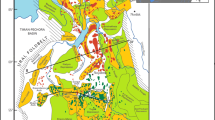Abstract
The distribution of trace elements, physical and chemical properties of the oil, and geological and geochemical features of oil formation in world oil and gas basins were studied. It was shown that hydrocarbon ontogenesis associated with deep tectonic transformations (geodynamic factor) controls not just the distribution of naphthides in the sedimentary cover, but also the diversity of their metallogenic specialization. The classification of oils from various ontogenesis zones is given in accordance with their enrichment in trace elements and with the metallogenic (vanadium or nickel) type. Oil characterized by large primary concentrations of trace elements of the main zone of oil formation and oil with low initial concentrations of trace elements in the zones of early generation are presented. Transformation of the oil composition in the areas of hypergenesis leads to their enrichment, whereas the oil of the catagenesis zone is depleted in trace elements.



Similar content being viewed by others
REFERENCES
K. N. Kravchenko, Basin Foundation for the General Theory of Naphthidogenesis (NIA Priroda, Moscow, 2004) [in Russian].
S. A. Punanova, Trace Elements in Oils: Their Use in Geochemical Research and the Study of Migration Processes (Nedra, Moscow, 1974) [in Russian].
S. A. Punanova, Geochem. Int. 36 (9), 860–874 (1998).
S. A. Punanova and T. L. Vinogradova, Geochem. Int. 54 (9), 817–824 (2016).
D. Li, R. Li, T. Xue, et al., Minerals 8, 2–17 (2018).
M. Escobara, G. Marquezc, V. Azuajed, et al., Fuel, No. 7, 186–196 (2012).
F. Galarraga, K. Reategui, A. Martinez, et al., J. Petrol. Sci. Eng. 61 (4), 9–14 (2008).
I. F. Lositskaya, S. A. Punanova, V. I. Tikhomirov, et al., Neftegaz. Geol. Geofiz., No. 2, 14–16 (1982).
S. A. Punanova, Geochem. Int. 52 (1), 57–68 (2014).
C. Duyck, N. Miekeley, T. C. O. Fonseca, et al., J. Braz. Chem. Soc. 19 (5), 978–986 (2008).
S. A. Punanova and T. L. Vinogradova, Dokl. Earth Sci. 456 (2), 677–685 (2014).
R. P. Gottikh, B. I. Pisotsky, and D. Z. Zhuravlev, Dokl. Earth Sci. 422 (1), 1084–1089 (2008).
I. S. Gol’dberg, Geol. Nefti Gaza, No. 3, 2–7 (1990).
Funding
This work was written as part of a state assignment on the topic “Development of the Scientific and Methodological Foundations of the Search for Large Accumulations of Hydrocarbons in Nonstructural Traps of a Combined Type within the Platform Oil and Gas Basins.”
Author information
Authors and Affiliations
Corresponding author
Additional information
Translated by M. Hannibal
Rights and permissions
About this article
Cite this article
Punanova, S.A. Trace Elements in Naphthides in Oil and Gas Basins. Dokl. Earth Sc. 488, 1207–1210 (2019). https://doi.org/10.1134/S1028334X19100179
Received:
Published:
Issue Date:
DOI: https://doi.org/10.1134/S1028334X19100179




